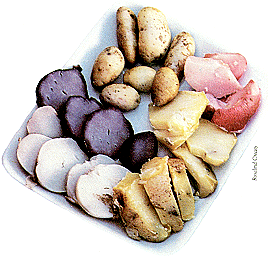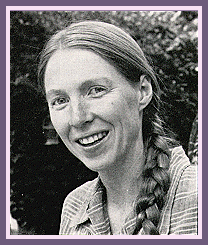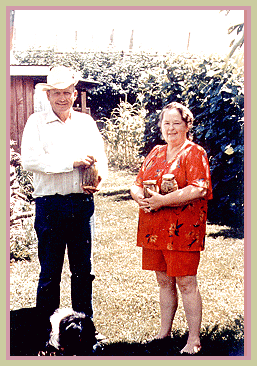
Gardens for All
The Gardener's Newsmagazine
April, 1985
"Seeds Blüm Blooms!"
by Kit Anderson
| Jan Blüm had a hard time finding the seeds she wanted to sell in her catalog until she turned to home gardeners for help -and saved her company from extinction. |
 |
Colorful red, white, blue and yellow potatoes, part of the Blüm collection of unusual vegetable varieties. |
Seeds Blüm started out modestly enough four years ago, a small seed company offering a handful of unusual vegetable varieties difficult to find through the regular sources. Among them were heirlooms and others notable for their flavor, size or color.
Jan Blüm and her partner Karla Prabucki believed it was important to keep these strains growing, so Jan raised a selection in her own gardens, figuring she had plenty of space to keep up with their customers.
The second year the list of varieties expanded a lot, and she still thought she could keep up. "That spring," says Jan, "We found ourselves cross-eyed and exhausted trying to fill orders while planting the gardens for next year's harvest. We discovered that seed marketing is much like selling other commodities." Either they had to find another way to raise seeds of their heirlooms or give up their plans for running a seed company.
Most retail seed companies buy their seed from wholesalers. The wholesalers buy their seed from contract seed growers. Sometimes seeds go through several hands between the seed grower and the retail seed company that finally sells to the gardener. "Wholesalers were a welcome source of seeds for small companies while they were still selling plenty of open-pollinated varieties, and were willing to deal in small quantities," says Jan. "But the last ten years have seen a shift in the see d world. Breeding interests have swung to hybrids and wholesalers have set minimum quotas on the amounts of each seed variety they sell. Unless you can order a certain amount, you can't order at all. This can destroy a small seed company that needs small amounts of many different kinds of seeds."
They thought about ordering seeds from abroad, as other small companies wanting to offer unusual varieties have done, but the problem of quantities was still there; and the heirlooms they wanted to offer just can't be bought.
Home growers to the rescue
Jan found the answer at a farmer's conference where she was discussing her problem with a county extension agent. "She told me her county had a master gardener program and suggested that many of these folks would be happy to raise small quantities of seed and harvest a little extra cash for their efforts," says Jan, "and I couldn't believe we hadn't thought of that before. We came home and madly started converting pound and ounce measurements into cups and tablespoons. We worked out th e maximum price that we could pay for each variety and how much seed we need - minimum and maximum amounts. It took us a season of working with understanding growers to polish up communication systems, but our 'home grower network' saved our business from extinction."
When you think about the logistics involved in maintaining such a system, it has the makings of a nightmare. Seed grown for sale must be pure, healthy, clean, and have excellent germination rates. Where can you find enough gardeners with the necessary skills, and how can you possibly ensure the amateur growers will provide seed that meets strict standards?
No problem, or at least few serious ones, according to Jan. Gardeners are conscientious people. She now has over 50 growers in different parts of the country.
So far the seed has been of excellent quality, and she's had no complaints from customers. Because of the growers' network, the catalog now offers over 500 varieties of heirloom and ornamental vegetables, flowers and herbs, and has tripled in size each year.
Jan started out with a questionnaire tucked in with seed orders, asking customers if they'd be interested in growing seed to sell to her, or participating in a testing program for new varieties she was considering. That helped her locate some prospects. She found others through her plant search service. Several times when she was able to locate hard-to-find varieties for gardeners, they became friends who offered to grow extra seeds for sale in catalog.
"Actually, a lot of my growers aren't all that interested in the money. They do appreciate being treated seriously, like the careful growers they are, but the real reward for them is in getting these varieties out to people."
Some growers get started when they offer Seeds Blüm some seed of a variety they happen to be saving as a seed crop every year. "One woman wrote on the back of an order form that she had some perilla seed, and could we use it," says Jan. "I wrote back to say sure, and we started corresponding. Now she grows 55 varieties of seed crops for me in her back yard, just small quantities of each."
Conscientiousness is the key
"The traits we have come to value as trademarks of an 'excellent grower' are conscientiousness and an ability to be honest when there is a problem or question. Anyone with that disposition will find us more than happy to cooperate in setting them up as a seed grower."
When a gardener first suggests he or she is interested in growing seed, Jan sends out a thorough questionnaire that lets her know just how experienced a gardener this is, what methods are used in the garden, what sort of climate the garden is in, how big it is and how much he knows about seed saving. She also asks for photos of gardener and garden - "It really helps," she says, "to get some idea of that person."
If the gardener is just starting to save seed, she'll suggest participating in the Trial Garden program for at least a year. That means growing a variety and keeping detailed records on its growth; for those who want to grow seeds for sale, she asks that they save some of that crop and return it to Seeds Blüm at the end of the season. "We've found that some of the less experienced gardeners turn out to be some of our best growers," says Jan. " ;They're much more likely to call or write if they have questions. Then we can work with them to solve the problem and be sure the crop is healthy." By working with her growers, supplying them with the best information, she's managed to teach them good seed saving techniques.
The amount of seed grown can vary from a cup of tomato seeds to several gallons of beans. One grower in Oregon supplies all the bronze fennel seed for the catalog - it's a low-demand crop, so it doesn't take much. Another grower in California, who has only 10 4'x8' garden beds, grows not only vegetables for herself, but seed crops of leeks, Russian kale, and red celery.

"One problem you can run into with a small garden is that it's tempting to grow just one plant of a prolific crop like celery, which can easily produce four cups of seed per plant. To prevent what we call inbreeding depression it's much better to have seed from at least several different plants, so I insist on that with my growers. Of course a small garden also limits your choice of seed crops, since you can't get them far enough apart to prevent cross-pollination."
The most popular seed crops are beans and tomatoes, which is fine because these are also the most popular in the catalog. Tomatoes are a great seed crop because the gardener can make sauce of the pulp and still sell the seed. Hardest to find are growers for the cabbage family, carrots and others which are biennials or seed crops (such as peppers) that may need to be caged to prevent pollen from other varieties from spoiling the seeds.
Quality comes first
"The one thing we fuss about is quality. We offer the highest quality seeds to our customers; in order to do that we must demand nothing but the best from our growers." Occasionally seed doesn't meet standards. "Last year we got one of those huge laundry soap boxes full of orach seed that had been cleaned perfectly. But germination rates were very low. I talked with the growers and found that they had dried the seed over a wood stove, which is much too hot and can damage the embryo inside. The same thing can happen with dehydrators. Later I noticed small white spots on the seeds and some were green, so I suspect they had also been exposed to too much moisture, either from rain or fog, which had caused mildew and some premature sprouting. We couldn't buy the seed, of course, but they were very understanding about the whole thing. It's sometimes tricky to get a good seed crop in a damp climate."
Usually when seed comes in they weigh it, do germination tests, then pay on the basis of that. They've tried so far to make sure that growers don't need to invest in special equipment; that's why although they much prefer completely clean seed, they offer to do the final cleaning if necessary.
This unorthodox method of obtaining seed takes a tremendous amount of time and devotion. The "correspondence room" in the office is the heart of the business. It's filled with all the forms and brochures sent to growers, and on the walls are maps, charts of trial gardens and photos of gardeners. You have to love the process itself in order to keep up all the writing and calling and coordinating it takes, and to be on call for questions at all times. It's clear that for Jan and her partner, much of the satisfaction with their business comes from this work with people.
Family-heirloom seeds
That's appropriate, since most who value heirloom seeds do so not just for their special qualities, but also for the human history behind them. There are stories behind many of the seeds in the catalog.
 After an article on Seeds Blüm appeared in a local Idaho paper, Jan got an
invitation from a woman in the neighborhood who had some beans to show her. One
was a pink-blossomed pole bean. When Jan tasted some of the beans canned, she
was sure they must have been canned with butter - "They were the best tasting
beans I'd ever had," she says. Her hostess, Lugene Newell, called the variety
"Grandma beans," (she got them from her mother, who got them from her mother).
After an article on Seeds Blüm appeared in a local Idaho paper, Jan got an
invitation from a woman in the neighborhood who had some beans to show her. One
was a pink-blossomed pole bean. When Jan tasted some of the beans canned, she
was sure they must have been canned with butter - "They were the best tasting
beans I'd ever had," she says. Her hostess, Lugene Newell, called the variety
"Grandma beans," (she got them from her mother, who got them from her mother).
Lugene then told Jan that when an elderly friend had visited her and seen another variety of her dried beans on the shelf she'd thrown up her hands and yelled "Deschutes beans!" Apparently there'd been a family in the area, living right above the Deschutes Dam, who had a strain of extremely prolific beans. People used to drive their horse-drawn wagons out to the farm, load up entire bean plants, and pay by the wagon load. Lugene and her husband Claude, who is now growing both beans for Seed s Blüm, call the dried ones "Two-eyed Yanks" so that's how they're listed in the catalog.
Naming can be a problem in any listing of heirlooms, since many have been passed around and occasionally renamed, so Jan and Karla have tried to include all the names they know of each variety, to help anyone trying to locate a particular strain.
Potato varieties
Learning the seed business hasn't been exactly easy, especially since the rules aren't always clear. Jan's been collecting potato varieties for four years, and now has over 90 different types. They include a range of colors from red to yellow and blue; some are great keepers, others are especially early or resistant to drought or heat. She's managed to maintain them from season to season, but has only recently begun to offer a few of the potatoes through the catalog. (Special note: Seeds Blum now offers over 42 varieties of potatoes.)
Meanwhile, the mail keeps pouring in. "We have a mailbox three times the normal size, and we're thinking of putting in a barrel," says Jan. The company has tripled in size each year, a clear sign that something's working. "We want to encourage small-scale farmers as much as possible," says Jan. "As we grow, some of our growers will be able to expand their plantings, so we'll be helping them as they're helping us. And think of all the varieties we'll be able to save."
This article is republished, for educational purposes. Text and images carry the copyright of their respective authors, photographers, and publishers. This page may be freely linked but not duplicated in any fashion without prior written permission of the respective copyright holders.
|
|